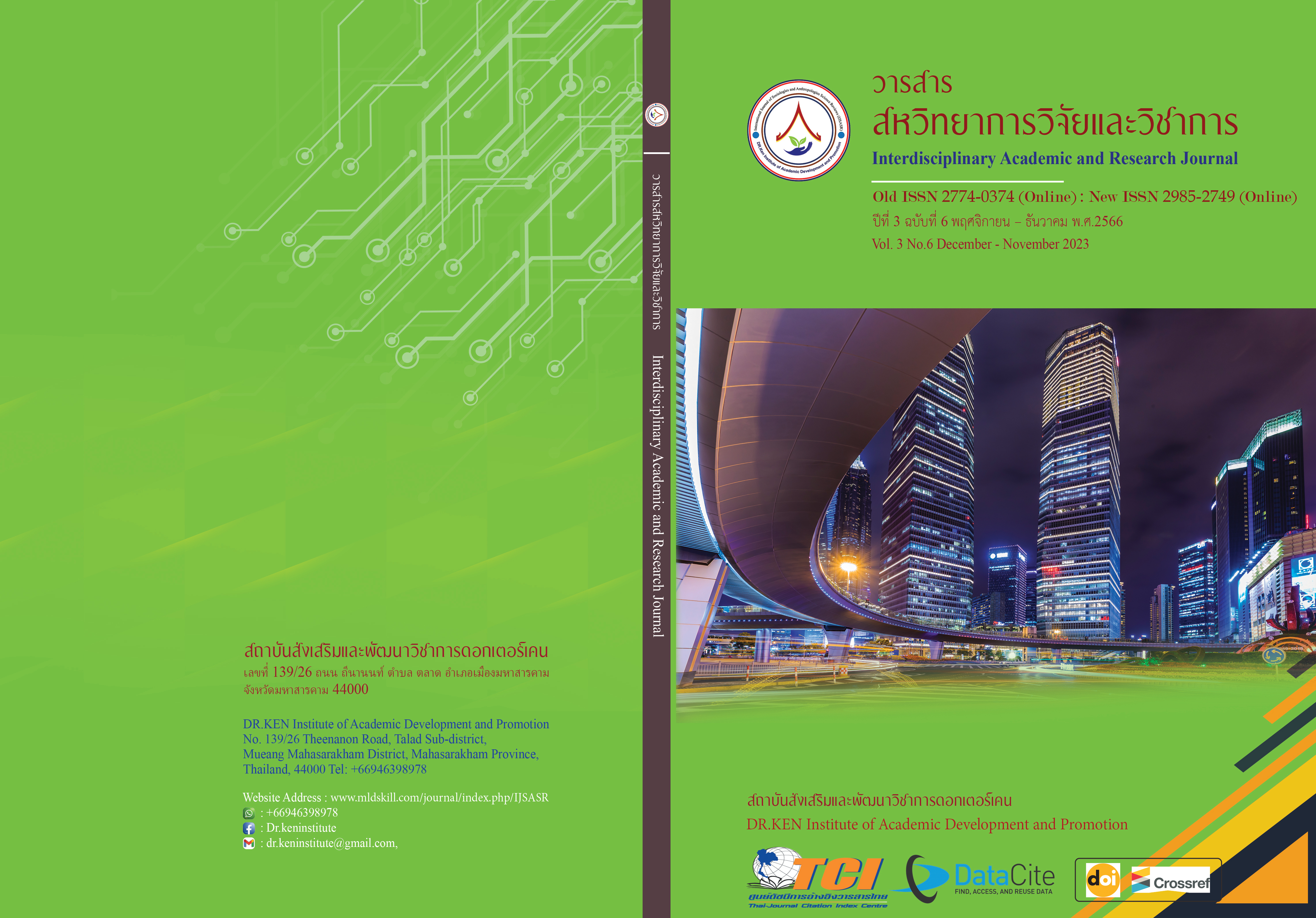The Development of Group Investigation Learning Activities for High School Students, Informal and Independent Education Center
DOI:
https://doi.org/10.60027/iarj.2023.270915Keywords:
Group Investigation; , Self –Directed Learning; , Learning AchievementAbstract
Background and Aims: Organizing science teaching activities to be effective and successful according to the curriculum requires teachers to adhere to the principles of student-centered education. Therefore, activities must encourage learners to discover themselves and find an understanding of what is meaningful to them. Developing collaborative group inquiry learning activities into a creative problem-solving process. Thus, the purpose of this research was to: (1) Develop Group Investigation learning activities for high school students with the efficiency criterion of 80/80. (2) study the Self-directed learning in Group Investigation learning activities for high school students. (3) Compare learning achievement between before and after using Group Investigation learning activities of high school students. And (4) Study for the satisfaction of students who learned through Group Investigation learning activities.
Methodology: The samples were 30 students of high school students in the 1st semester of the academic year 2019 at Kae Dam District Non-Formal and Informal Education Center, Maha Sarakham Province, and the samples were selected via Purposive sampling. The instruments used in this research consisted of the learning plan, Self–Self-directed learning assessment, scientific achievement test, and the questionnaire of student satisfaction. The statistics used in data analysis were percentage, mean, standard deviation, and t-test (Dependent Samples).
Results: (1) Development of Group Investigation learning activities on natural resources and the local environment which consists of heading, concept, learning standards, level learning standards, learning objectives, desired characteristics, activities, teaching materials/learning resources and Assessment. The six steps of group Investigation learning activities are detailed: identifying the topics, Planning the investigation in the group, carrying out the investigation, Preparing a group report, Presenting a group report, and Evaluating. The Group Investigation learning activities found that the efficiency was 80.97/80.41, which showed the efficiency with the 80/80 criterion. (2) Students are self-directed in their Group Investigation learning activities at a good level, (3) The average post-test score of the student after using Group Investigation learning activities was higher than the pretest at the .05 level of statistical significance. (3) Students had satisfaction with Group Investigation learning activities at a high level.
Conclusion: The development of cooperative group learning activities about natural resources and the local environment for high school students has a comprehensive structure and students show good self-direction ability in cooperative learning activities. This causes academic achievement after study to increase and satisfaction with this activity is at a high level.
References
เขมกร อนุภาพ. (2560). การใช้การเรียนรู้แบบนำตนเองเพื่อพัฒนาการเรียนรู้วิชาคอมพิวเตอร์ของนักเรียนชั้นประถมศึกษาปีที่ 4. วิทยานิพนธ์ปริญญามหาบัณฑิต: มหาวิทยาลัยธุรกิจบัณฑิตย์.
กระทรวงศึกษาธิการ, (2551), หลักสูตรแกนกลางการศึกษาขั้นพื้นฐาน พุทธศักราช 2551, กรุงเทพฯ: ชุมนุมสหกรณ์การเกษตรแห่งประเทศไทย.
กันตาภา สุทธิอาจ. (2561). การพัฒนารูปแบบการเรียนการสอนแบบเน้นประสบการณ์ตามสภาพจริง เพื่อส่งเสริมคุณลักษณะการเรียนด้วยการนำตนเองของนักเรียนชั้นมัธยมศึกษาตอนต้น. วิทยานิพนธ์ศึกษาศาสตรดุษฎีบัณฑิต, สาขาหลักสูตรและการสอน มหาวิทยาลัยธุรกิจบัณฑิตย์.
ชฎาภรณ์ จันทร์ประเสริฐ และเสาวภา วิชาดี.(2555). การปรับวิธีเรียนเปลี่ยนวิธีสอนเพื่อเสริมสร้างทักษะการเรียนรู้ด้วยการนำตนเองของผู้เรียน. วารสารนักบริหาร. 32(2), 143-149.
พงศ์พัชร์ รัตนะ และวีระเทพ ปทุมเจริญวัฒนา. (2558). ผลของการจัดกิจกรรมการเรียนรู้ ด้วยเทคนิคการสนทนากลุ่มที่มีต่อพฤติกรรมการเรียนรู้ด้วยการนำตนเองของนักศึกษาการศึกษานอกระบบ. วารสารอิเล็กทรอนิกส์ทางการศึกษา, 10(4), 652-661.
ภาพพิมพ์ เชื้อทหาร และ วรรัตน์ ปทุมเจริญวัฒนา. (2564). ผลของการจัดกิจกรรมการเรียนรู้ด้วยการน าตนเองโดยใช้เทคโนโลยีแบบเคลื่อนที่ ที่มีต่อการรู้สารสนเทศของนักศึกษาการศึกษานอกระบบและการศึกษาตามอัธยาศัย. OJED, 16 (2), 1-15.
วัชราพรรณ์ สอนจินซือ (2560). การพัฒนาบทเรียนบนเว็บด้วยเทคนิคกลุ่มสืบสวนสอบสวน เพื่อส่งเสริม ความสามารถในการคิดวิเคราะห์ สำหรับนักเรียนชั้นมัธยมศึกษาปีที่ 6. วารสารวิชาการ มจร บุรีรัมย์. 1(1), 62-71.
ศูนย์การศึกษานอกระบบและการศึกษาตามอัธยาศัยอำเภอแกดำ. (2561).รายงานการประเมินตนเองของสถานศึกษา (Self – Assessment Report) ประจำปี พ.ศ. 2561. มหาสารคาม: ศูนย์การศึกษานอกระบบและการศึกษาตามอัธยาศัยอำเภอแกดำ.
สถาบันทดสอบทางการศึกษาแห่งชาติ. (2560). รายงานผลการทดสอบทางการศึกษาระดับชาติ ด้านการศึกษานอกระบบโรงเรียน (N-NET) ระดับมัธยมศึกษาตอนปลาย ครั้งที่ 1 ปีการศึกษา 2560 ฉบับที่ 5 ค่าสถิติพื้นฐานสำหรับอำเภอจำแนกตามรายวิชา อำเภอแกดำ จังหวัดมหาสารคาม ภูมิภาค สถาบัน กศ: ภาคตะวันออกเฉียงเหนือ สาระความรู้พื้นฐาน (422). Retrieved from: http://www.allnetresult.niets.or.th/NNET/AnnouncementWeb.
สำนักงานส่งเสริมการศึกษานอกระบบและการศึกษาตามอัธยาศัย. (2551). หลักสูตรการศึกษานอกระบบระดับการศึกษาขั้นพื้นฐาน พุทธศักราช 2551 . กรุงเทพฯ: สำนักงานส่งเสริมการศึกษานอกระบบและการศึกษาตามอัธยาศัย.
อัศวี เมมิยานนท์ สมศิริ สิงห์ลพ นพมณี เชื้อวัชรินทร์ และมันทนา เมมิยานนท์ (2562). ผลการจัดกิจกรรมการเรียนรู้แบบวัฏจักรการสืบเสาะหาความรู้5 ขั้น (5Es) ร่วมกับการจัดการ เรียนรู้แบบร่วมมือด้วยเทคนิคกลุ่มสืบค้น (GI: Group investigation) เรื่อง ระบบสุริยะ ที่มีผลต่อผลสัมฤทธิ์ทางการเรียนและพฤติกรรมการทำงานกลุ่ม ของนักเรียนระดับชั้นประถมศึกษาปีที่ 4. มหาวิทยาลัยบูรพา.
Knowles, M. (1975). Self-Directed Learning: A Guide for Learners and Teachers. Chicago, IL: Follett Publishing Company.
Slavin, R. E. (1995). Cooperative learning: Theory, research, and practice. Boston: Allyn & Bacon.
Downloads
Published
How to Cite
Issue
Section
License
Copyright (c) 2023 Kanlayanee Khamlue, Wanida Pharanat

This work is licensed under a Creative Commons Attribution-NonCommercial-NoDerivatives 4.0 International License.
Copyright on any article in the Interdisciplinary Academic and Research Journal is retained by the author(s) under the under the Creative Commons Attribution-NonCommercial-NoDerivatives 4.0 International License. Permission to use text, content, images, etc. of publication. Any user to read, download, copy, distribute, print, search, or link to the full texts of articles, crawl them for indexing, pass them as data to software, or use them for any other lawful purpose. But do not use it for commercial use or with the intent to benefit any business.
















.png)


